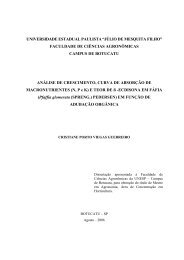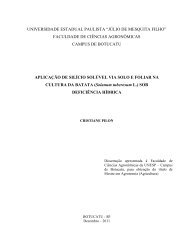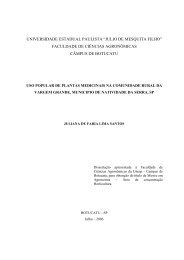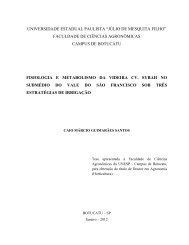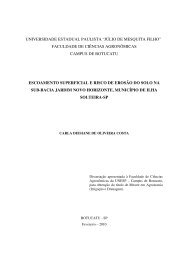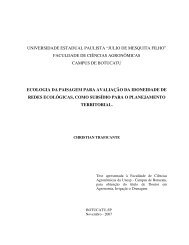PRODUÃÃO DE VINHO DE UVAS DOS CULTIVARES NIÃGARA ...
PRODUÃÃO DE VINHO DE UVAS DOS CULTIVARES NIÃGARA ...
PRODUÃÃO DE VINHO DE UVAS DOS CULTIVARES NIÃGARA ...
You also want an ePaper? Increase the reach of your titles
YUMPU automatically turns print PDFs into web optimized ePapers that Google loves.
X<br />
WINE PRODUCTION FROM NIAGARA ROSADA AND BORDÔ GRAPES:<br />
PHYSICOCHEMICAL, SENSORIAL ANALYSES AND ETHANOL RECOVERY FROM<br />
POMACE. Botucatu, 2006. 93 p. Tese (Doutorado em Agronomia / Energia na Agricultura) -<br />
Faculdade de Ciências Agronômicas, Universidade Estadual Paulista.<br />
Author: Daniela Barnabé<br />
Adviser: Waldemar Gastoni Venturini Filho<br />
Co-adviser: Helena Maria André Bolini<br />
SUMMARY<br />
The Brazilian winegrowing activity is characterized by small properties, family labor, and<br />
table wine production. However, there are few studies on table wine, despite more than 80%<br />
of the country’s wine production originates from American or hybrid grapes. This study was<br />
accomplished with small wine producers from Lençóis Paulista/SP who produce wine from<br />
American grapes (mainly Niagara). Table wine production from Niagara Rosada and Bordô<br />
grapes, their physicochemical and sensorial characterization, and the ethanol recovery from<br />
pomace were the aims of this study. Wine production was conducted with skin maceration<br />
with each variety being individually processed. The treatments were the varied proportional<br />
assemblage of both wines. Pomace was distilled in a simple copper still, and after redistilled<br />
for ethanol recovery. Sensorial analysis was performed by the acceptance test, using the



